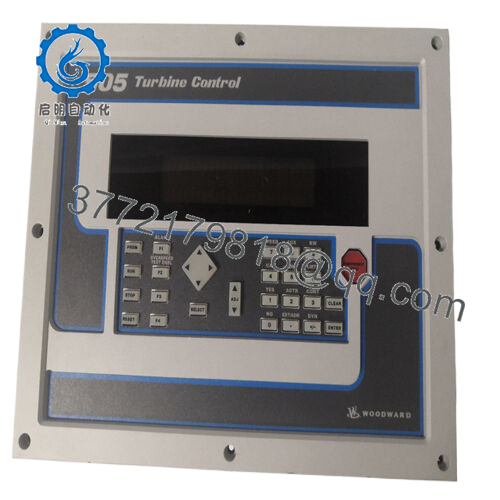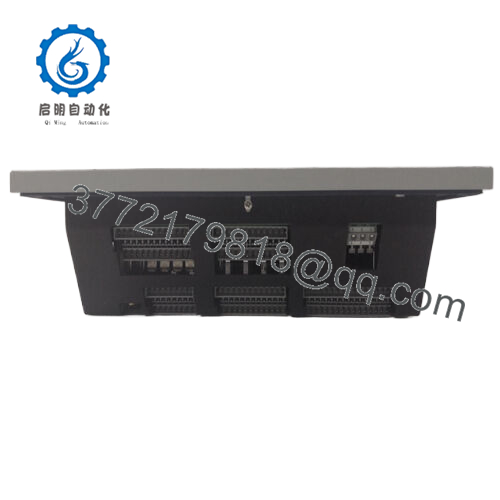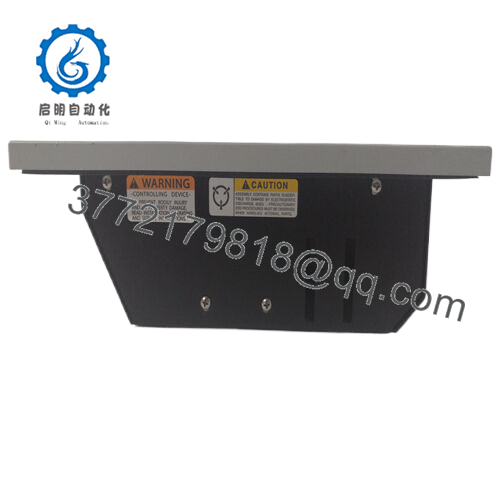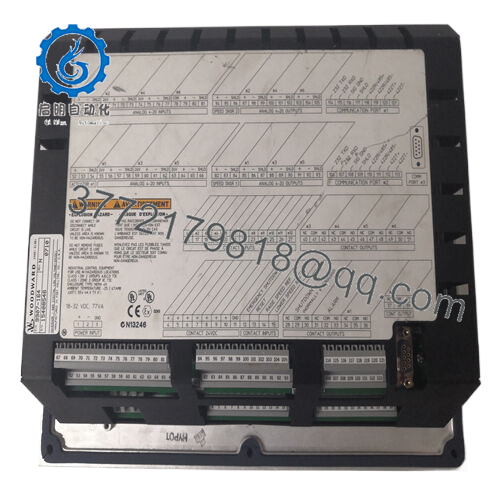Description
In the high-stakes domain of industrial automation, where steam turbine governors must orchestrate speed and load with split-second fidelity to avert inefficiencies or mechanical distress, legacy analog systems often reveal their limits—grappling with imprecise extraction control that leads to steam waste, vibration harmonics, or grid desynchronization during ramp-ups. Envision a cogeneration facility where fluctuating extraction pressures from process steam demands unsettle turbine stability, or a district heating plant where split-range actuators for admission valves falter under variable loads, risking thermal mismatches that curtail output or trigger overspeeds. These challenges are endemic to process control setups, where I/O signal demands for multi-stage throttling outstrip rigid hardware, compelling engineers toward cumbersome hydraulic tweaks or auxiliary relays that escalate wiring burdens and calibration downtime. High reliability demands more: it calls for adaptive digital oversight compliant with API 670 and IEC 61508 SIL 2, yet without it, expansions devolve into protracted validations or efficiency drags.
This is the governance gap the Woodward 9907-164 closes as a configurable microprocessor controller in the 505/505E series, tailored for single extraction/admission steam turbines with split-range precision. In arenas like petrochemical refineries or utility peaking stations, it surfaces as crucial amid throughput surges, where retrofitting for dual-actuator drives overwhelms basic controllers; lacking such a module, teams contend with manual sequencing that invites human lapses or fuel overruns. The Woodward 9907-164 interjects with programmable PID loops that modulate inlet valves via 4-20 mA outputs, incorporating critical speed avoidance to skirt resonances while its event recorder pinpoints first-out shutdowns. This goes beyond basic throttling—it’s a front-panel empowered nexus with conformal hardening for corrosive steam environs, upholding I/O signal integrity across cycles.
For evaluators balancing upgrades, the Woodward 9907-164 sharpens focus: it halves tuning iterations through menu-driven reconfiguration, meshing with Modbus for DCS handoffs, and its NEMA 4X rating streamlines hazardous-zone deploys. In turbine-reliant operations, where every kW ties to revenue, this controller’s auto-start sequences minimize thermal wear, reshaping control frailties into scalable proficiency. Whether stabilizing a turboexpander in gas processing or syncing a turbogenerator to the grid, the Woodward 9907-164 arms your stack with the modular integration that champions process control, blending legacy compatibility with forward agility.
Centrally embedded in the 505/505E control chassis, the Woodward 9907-164 commands as the algorithmic helm for turbine dynamics, panel-mounting via DIN-rail where it harnesses 24 VDC rails to fuel its 32-bit processor for real-time execution of speed/load governors. It interconnects through the system’s backplane, ingesting 16 contact inputs—four fixed for essentials like remote reset, 12 tunable for custom alarms—and six 4-20 mA analogs from transducers like throttle positions or extraction headers, then dispatches dual analog outputs to split-range servos for valve orchestration. In the I/O hierarchy, it perches upstream of field actuators, downstream of speed probes, where processed references cascade to Woodward’s servo amps or remote racks, fostering redundancy via dual-channel MPUs for bumpless failover.
- 9907-164
Its consultative weave shines in field adaptability: the integrated 30-key keypad and 2×24 LCD facilitate onsite parameter sculpting—from droop curves to ramp rates—while RS-232/422/485 serial ports (up to 57.6 kbaud) link to HMIs or Gap software for deeper diagnostics, quelling EMI via isolation barriers. For a condensing turbine’s load share, the Woodward 9907-164 buffers extraction signals to preempt pressure swings, pulsing outputs in sequenced profiles; built-in limiters cap valve travel, averting stem overloads. This locus bolsters the automation edifice—chain with expansion modules for 100+ I/O sprawl, or hybridize with microNet for TMR safety—while NEMA 4X sealing endures 95% humidity. The Woodward 9907-164 thus integrates as a perceptive director, diagnostics that foresee deviations, and configurability that evolves sans panel teardowns.
| Specification | Details |
|---|---|
| Model Number | 9907-164 |
| Brand | Woodward |
| Type | Digital Microprocessor Governor Controller |
| Input Voltage | 18-32 VDC |
| Operating Temp Range | -25°C to +65°C |
| Mounting Style | Panel/DIN-rail |
| Dimensions | 14 x 11 x 4 in (356 x 279 x 102 mm) |
| Weight | 9.11 lbs (4.13 kg) |
| Interface/Bus | Backplane, RS-232/422/485 |
| Compliance | IEC 61508 SIL 2, API 670, Class I Div 2, NEMA 4X, CE |
| Supported Protocols | Modbus RTU |
| Typical Power Draw | 77 VA |
Adopting the Woodward 9907-164 cements reliability where programmable limiters forestall actuator saturation during transients, enabling turbines to hug setpoints within 0.25% amid steam variances—your cycles run leaner, sidestepping the efficiency dips that once sapped margins, all while isolated inputs repel noise from adjacent exciters. In extraction-heavy runs, this precision curbs bleed steam losses, stabilizing process headers without the oscillatory hunts plaguing analog rigs.
The care regimen lightens appreciably, as the event logger and first-out relays distill faults—from MPU gaps to overtravel—into LCD cues, accelerating triage from shifts to snapshots and easing engineering strains for roving squads. Forged for the rigor of baseload vigils, it affirms enduring vigor via humidity-proofed boards that brave 95% RH, elevating MTBF past 50,000 hours while paring spares to high-impact swaps. Amid fleet modernizations, the Woodward 9907-164‘s drop-in footprint hastens migrations to Ethernet overlays, dodging full recerts for logic ports.
Expand the vista, and its Modbus vein conduits trends to predictive suites, linking vibration spectra with load logs to herald bearing tweaks. Operators wield empowered autonomy via keypad overrides, trimming escalation loops in outage shadows. Endorsing the Woodward 9907-164 instills a governance that intuits flux, fusing responsive modulation with resolute stamina to advance your industrial automation from episodic to exemplary.
In combined-cycle gas plants, the Woodward 9907-164 stewards HRSG extraction turbines amid heat-recovery fluxes, where load-following tests extraction poise—its split-range pulses secure critical system uptime, modulating admissions in process control environments to balance power and steam without efficiency forfeits.
Pulp and paper mills harness it for backpressure drives, weathering pulp fibers and condensate; under these harsh conditions, the Woodward 9907-164‘s SIL 2 framework yields high reliability, auto-sequencing startups through resonances in fast data cycles for seamless sheet production.
Onboard marine steam propulsion, it governs geared sets through saltwater brine and rolls, with Div 2 hardening suiting engine rooms—its configurable droops enable precise maneuvering, minimizing exposure in confined process control environments. These enactments affirm the Woodward 9907-164‘s caliber for turbine tenders navigating extraction enigmas.
9907-162 – Analog variant for legacy hydraulic interfaces in basic admission controls
9907-165 – Enhanced 505E model with expanded analog outputs for dual-extraction setups
8200-1302 – Companion digital governor for integrated speed/load sharing with 9907-164
5466-1000 – MicroNet I/O module augmenting 9907-164’s discrete channels in hybrid stacks
8237-1600 – Overspeed relay pair for TMR protection alongside 9907-164 governors
9905-001 – MPU probe kit tailored for 9907-164’s speed input fidelity
505-7150 – Core CPU upgrade path from 9907-164 for Ethernet-enabled retrofits
8446-1037 – Analog expansion board extending 9907-164’s transducer roster in dense I/O
When prepping the Woodward 9907-164 for your 505 chassis, vet backplane revision—Rev K+ ensures firmware rapport, per Woodward’s interchange guide, to elude boot stalls; a Gap scan upfront flags variances. Assay panel convection; in >70% loaded bays, enforce 20 CFM inlets to peg internals under 65°C, and multimeter your DC span for <200 mV ripple—mating a surge suppressor curbs inrush jolts. Assay front-panel seals for gasket integrity, as micro-gaps invite steam etch in humid halls.
In operation, monthly Modbus dives for input drifts over 1% dovetail with LCD patrols for uniform key glows. Quarterly, enact self-proof via keypad—mimic a load reject to time ramp recovery below 5 s—and retorque rear terminals to 1.5 Nm, probing for looseness post-vibe episodes. For brine-kissed installs, biannual enclosure rinses with distilled wipe-downs thwart corrosion creep, synced with log archives for excursion profiling. These protocols nestle into turbine regimens, conserving the Woodward 9907-164‘s mettle absent undue diversions.





 WhatsApp: +86 16626708626
WhatsApp: +86 16626708626 Email:
Email:  Phone: +86 16626708626
Phone: +86 16626708626


